*please check our "Agenda" for your date.
Our cruises have been programed during the best possible season of the year. The sea is generally very calm as Cenderawasih is a bay almost closed at the entrance and protected from ocean swells
Tropical climate. Tropical weather, sunshine and nice sea breeze that can be windy at nighttime, light jacket is ideal
Certain stationary dives in mid water to observe the whale-sharks under the fishing platforms. Dives normally conducted on reef edges with wrecks, around coral atolls, some sand based diving and some drop offs. Currents and visibility can be varied.
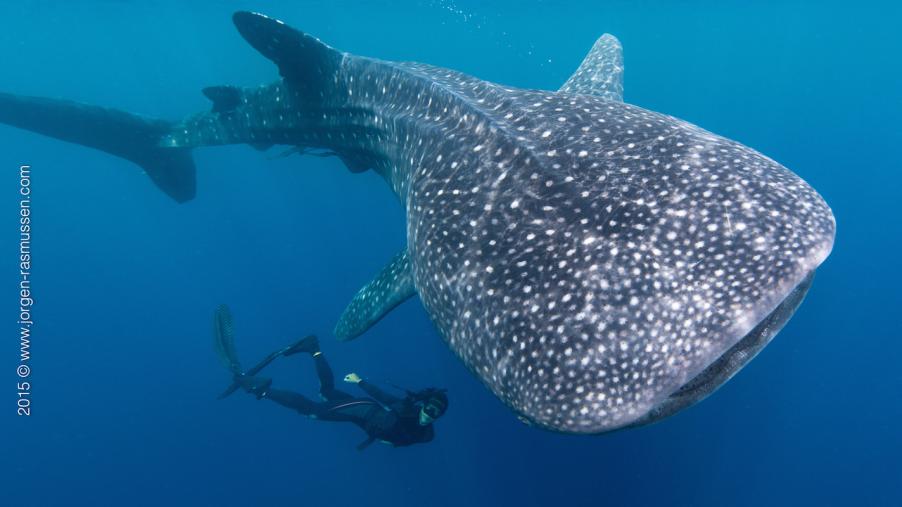
The WAOW staff will pick you up in your hotel, or await your arrival at Manokwari or Biak airport, to assist and accompany you to the liveaboard SMY WAOW in the harbor. Our experienced staff will look after your luggage and transfer it to your cabin onboard SMY WAOW while you enjoy our "refreshing welcome drink". As soon as the last guests are onboard, you will be introduced to our team and have plenty of time to settle in, get everything ready and enjoy your first day with us.
Early breakfast befor disembarkation & transfer to the airport or hotel between 06.00am and 11.00am at the latest
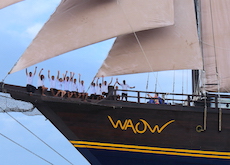
Papua Barat, located at the western tip of New Guinea, is one of the few hotspots of underwater biodiversity on earth. In the whole area scientists have counted more than 1800 different species of animals, more than anywhere else in the world
Close your eyes and just imagine for a moment….. on a beautiful blue sea, WAOW is approaching a sort of platform, floating about 100 meters from us. On the platform we meet the first locals we have seen for several days after cruising deserted locations, this is definitely something straight out of a Robinson Crusoe story. Cenderawasih Bay is a large bay in the northern Province of West Papua, Indonesia. The western part of the bay was declared a marine national park in 2002. Cenderawasih was ignored by diving guides for long periods of time until the endemic species in this area began to be studied by the scientific community. The bay still remains a little off the beaten track despite the exceptional diving opportunities and the biodiversity of the marine life. The platforms that we approach are traditional fishing platforms that go by the name of “bagan”. Fishermen live there for months on end and spend their days fishing with hand-lines. At night time they catch small anchovies in their nets, hung from under the platform by using projected lights. These nets hanging from the platforms attract the interest of the largest residents of Cenderawasih, the whale-sharks. These opportunistic whale-sharks have a feeding behavior well outside the ordinary. Normally whale-sharks feed by filtering plankton, but in this instance they await the dead fish, or almost dead, that fall or filter thru the nets. In most locations a whale-shark sighting is a less than a guaranteed affair and relies on a certain amount of good fortune. Not in Cenderawasih, we often see them before, during and after being in the water. The locals believe that the whale-sharks are under the protection of the spirits and therefore fishing them is traditionally prohibited. This seems to be in contrast with the name they have been given by the locals “Hiu bodoh” or "stupid shark". The whale-sharks are not the only attraction in Cenderawasih Bay. We also find WW2 wrecks in Manokwari and Mansinam, beautiful coral gardens in Biak, abundant and diverse schools of fish, surrounding atolls and rich drop-offs covered in black coral, sponges, sea fans and rich fauna. Cenderawasih also presents a unique particularity in that the bay is geographically isolated. Limited exchanges with the attached ocean have permitted a large number of varied and colorful species to develop in the bay. In some instances we find species that generally would only be found in much deeper waters. In addition to these exclusive elements mentioned, Cenderawasih Bay also offers the rich marine biodiversity native to Indonesia: Pygmy sea horses, frog fish, rare and classic nudibranches, several species of ghost pipe fish, mimic octopus, large varieties of crab and shrimp. Five new species of marine life have been discovered recently including a new dotty-back, and new garden eel. The number of species listed has now risen to 1’596. From an evolutionary scientists' point of view Cenderawasih Bay is considered as “The Galapagos of Indonesia”.
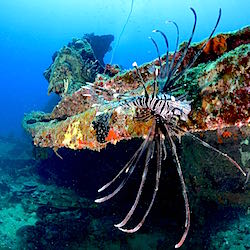
(only for trips starting or ending in Manokwari)
Many Japanese shipwrecks from the 2nd World War lie on the bottom in the Manokwari area. Bombed by the Americans in May 1944, these old warships are now the main attraction for divers in this part of Cenderawasih bay. The most popular ones are:
"Shinwa Maru” (The Good Ghost), is a huge, 120-meter-long cargo ship, lying in 35 meters of water. It sank near the port of Manokwari after having been hit by two bombs, leaving it with two holes in the bow. In one of the cargos are still cables and machinery once used to move bombs. There are also empty bomb shells around. There is a resident school of mackerel, who seem to be the caretakers of this wreck. The sides are nicely decorated with soft coral, hard coral and rock oysters.
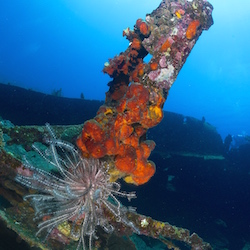
(only for trips starting or ending in Manokwari)
"Cross”, a former patrol vessel is 35m long and is lying at a depth of 18 meters, parallel to the coast of Mansinam Island, right in front of a cross symbolizing the arrival of the first missionaries in the mid-19th century to that area, hence the wreck’s name. This wreck and its surrounding slope is well known for good critter diving, especially at night.
"Pillbox”, This cargo ship was carrying ammunition and is roughly 60-65 meters long. It is lying on its starboard side in around 16 meters of water, just off the Coast of Mansinam Island. It is in good condition and well preserved.
"Pasir Putih” (The White Sand), a former military patrol vessel of 30-35 meters long, lies on a sandy bottom between 13 to 22 meters with its bow pointing towards the shoreline.
A wall and steep slope with good coral growth surrounded by clear, blue water and big fish. Baby Grey reef sharks, white tips, barracudas, tunas, big groupers, jacks, snappers can easily be spotted. The fish life is particularly good with some current running.
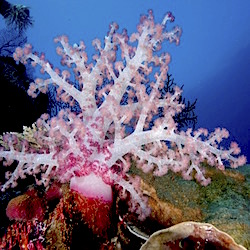
On Manim Island are more than 7 Landing crafts from the war. They all sit on a white sand slope and each one is decorated with different corals, at different depths between 40+ meters to a shallow 5 meters.
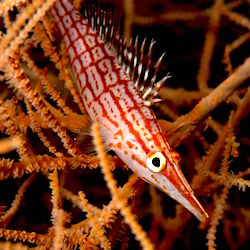
Pulau Auri features a shallow ridge, visible at low tide. Large rocks and boulders covered in both soft and hard coral. Some of the most prolific green Tubastrea hard corals of Cenderawasih grow here. Schools of Fusiliers along with hump head parrotfish, or the occasional small grey reef shark can be seen here. Tanjung Ayami is nice boulder dive with good coral growth and lots of Fusiliers and Barracudas.
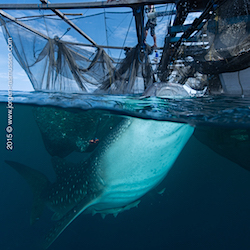
Now that is the reason why most people come this far… To dive under and around these floating fishing huts where Whale-Sharks congregate!
Tanjung Mangguar is a beautiful and interesting site. Huge soft coral and sea whip colonies adorn this reef which attracts a large number of fish including Barracudas, rainbow runners, jacks and even sharks, manta rays and mobula rays can be spotted regularly! Huge barrel- and elephant ear sponges, giant clams, gardens of Acropora hard corals and lots of fish, all in crystal clear water.
Dry Yapen is an underwater seamount where the currents can become strong. Starting at 8 meters and sloping down to 35 meters and more. Beautiful and huge soft corals decorate an intact reef full of life. Right next to Yapen is a big plateau extending the beach as a ridge, with sandy slopes falling to the deep, or single standing bommies, with nice corals.
The Padaido Islands offer diverse diving ranging from walls to slopes, pinnacles, plateaus and even wrecks. Fish life such as small critters, reef fish, schools of jacks and barracudas as well as juvenile sharks. There is a great muck or night dive under the concrete pier from Mios Wundi village with many critters to be found.
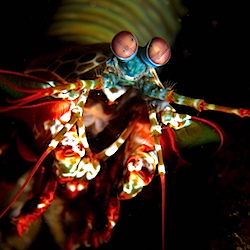
The "Flying Catalina" is a plane wreck in good condition just outside of Biak and easy to dive. Shallowest depth is 19 meters and the deepest at 30. The plane is in one piece, in a good shape with big black corals, gorgonians, big lion fish, glassfish, shrimps and many more. The "Pasar Ikan" (Fish Market) Is a good muck dive with critters such as Cockatoo waspfish , ghost pipefish etc.
Hello
Hello
Hello
Hello